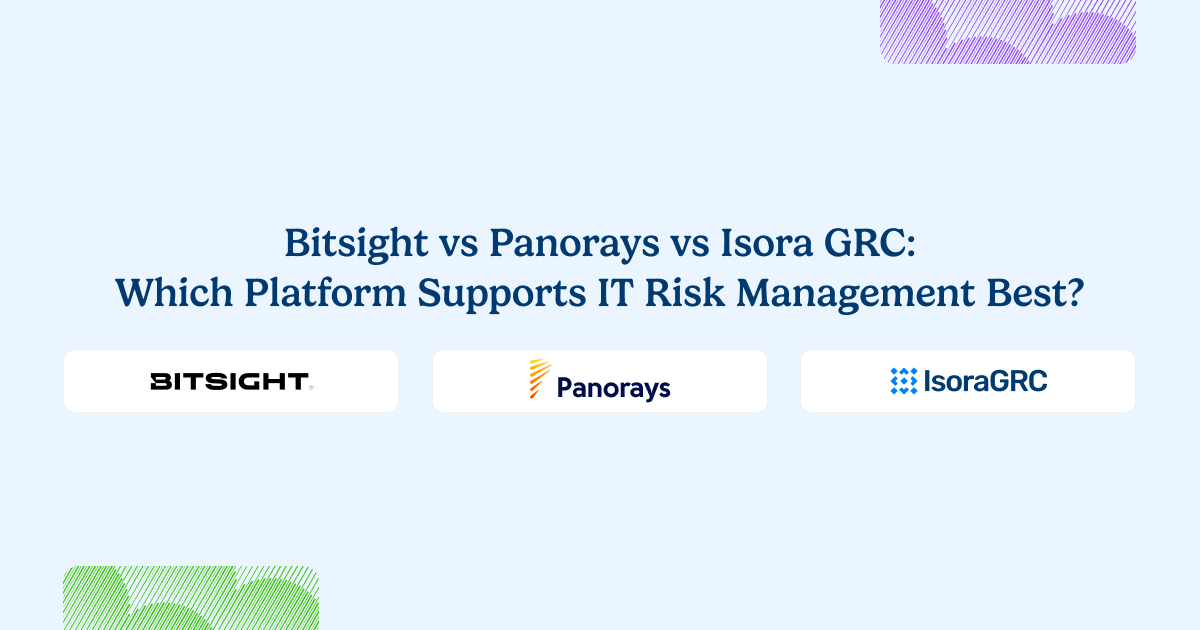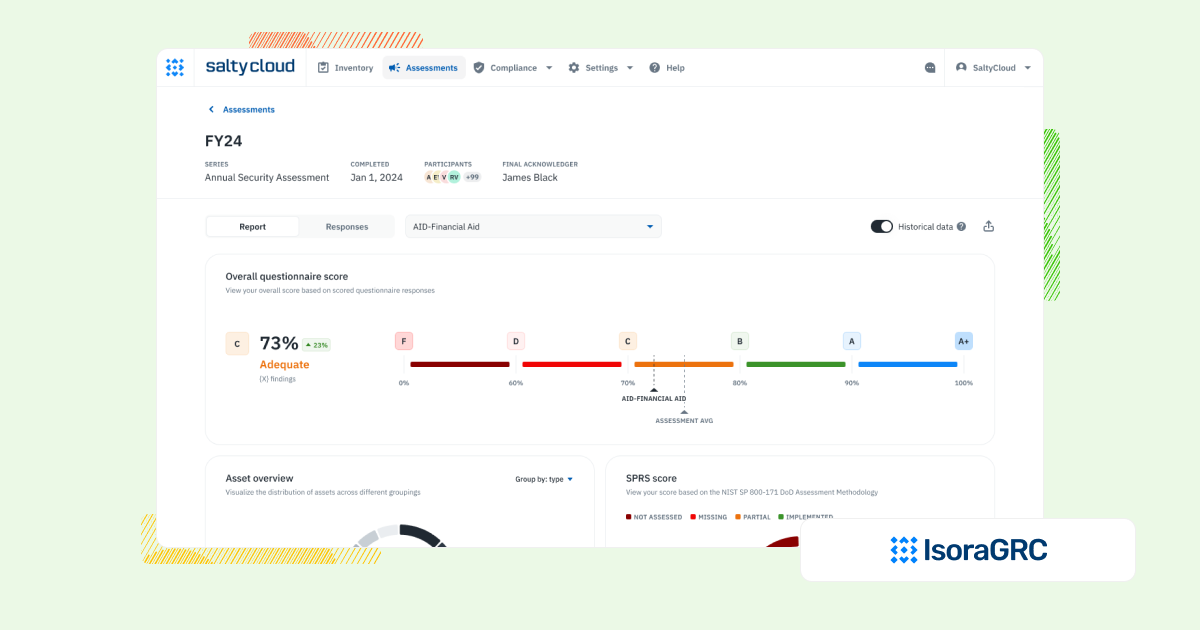
Every security team needs a complete, scalable way to manage IT risk—not just rely on vendor scores.
Platforms like Bitsight and Panorays provide vendor intelligence, offering external ratings to help identify potential risks across your third-party relationships.
External scores can highlight issues, but they don’t help you assess, track, or resolve those risks with the depth needed for comprehensive risk management.
Isora GRC brings a more effective solution. It’s purpose-built for security teams who need to run assessments, manage inventories, and track risks—moving beyond vendor scores to provide a full, actionable risk management solution.
Let’s take a closer look.
Choosing the Right Platform for IT Risk Management
Bitsight and Panorays are useful for monitoring vendor security posture—but neither platform supports the full workflow required for managing third-party risk. These tools are primarily built for generating automated risk ratings and highlighting surface-level vulnerabilities based on external signals.
While that visibility can be helpful, it doesn’t enable security teams to dig deeper into how a vendor manages its security controls or provide structure for reviewing documentation, collecting evidence, or collaborating on remediation.
Isora GRC was built for teams that need to operationalize vendor risk—not just observe it. It allows you to run customizable assessments, manage vendor and asset inventories, track exceptions, and maintain a living risk register. Whether you’re using frameworks like HECVAT, CAIQ, or SIG—or creating your own—Isora GRC gives you the tools to scale and repeat risk workflows across your vendor ecosystem.
The Workflow That Matters: Managing IT Risks and Compliance
Managing third-party risk isn’t just about knowing a vendor’s risk score—it’s about verifying the effectiveness of their controls, understanding their exposure in context, and ensuring accountability through documentation and remediation. With Bitsight and Panorays, security teams are left with insights but no way to act on them in a structured, auditable manner.
Isora GRC closes that gap. It supports real workflows: issuing assessments, collecting responses and evidence, identifying risks and exceptions, and documenting follow-ups across cycles. It also makes it easy to align with compliance frameworks (e.g., HIPAA, GLBA, NIST) by tying vendor assessments to broader enterprise risk workflows. Teams can assign ownership, collaborate in real time, and ensure vendor risk becomes an integrated part of the overall IT risk management program.
How Each Platform Supports IT Risk Management Workflows
| Workflow Area | Bitsight | Panorays | Isora GRC |
| Assessment Management | Bitsight tracks security ratings and third-party risks. But it may lack full assessment management features. | Panorays automates third-party assessments well. It’s strong for security questionnaires, but some users say internal tracking and custom assessments feel clunky. | Centralized, intuitive assessment dashboard across business units, vendors, and assets. Built specifically for security teams. |
| Questionnaire Delivery & Completion | Bitsight focuses on ratings, not on forms. Teams needing strong questionnaire tools may need extra help. | The platform shines in vendor questionnaires with automated reminders and scoring. Still, users report that customization beyond templates can be limited without support help. | Customizable and prebuilt questionnaires for frameworks like NIST, ISO, GLBA, HIPAA, and more. Designed for internal and external collaboration. |
| Inventory Tracking | Bitsight looks at external security, not asset tracking. This can limit teams with large inventories. | Vendor inventory updates automatically, which users like. But tracking internal assets or deeper relationships between vendors and assets needs more manual setup. | Centralized tracking of assets, vendors, and organizational units with integration support for existing data sources. |
| Risk Register & Exception Management | Insights on third-party risk exist, but deeper risk tracking is missing. Extra tools may be needed. | Panorays ties risks to vendors cleanly, but broader risk management feels secondary. Exception tracking is basic and often handled outside the platform. | Flexible, collaborative risk register with scoring, status, evidence, and ownership tied directly to assessments. Exception management is built-in and intuitive—no extra modules or configuration required. |
| Scoring, Reporting & Risk Visualization | Security scores come with insights, but risk visuals may feel too simple. | Vendor risk scoring is clear and easy to follow. Still, some users want more customizable risk models and stronger visual reports for executive presentations. | Automated scorecards, risk maps, and executive-friendly reports with actionable insights—no manual config required. |
| Collaboration & User Experience | The interface suits security pros. Still, team collaboration tools feel limited. | User interface feels modern and responsive. Teams can review vendors quickly, but real collaboration—like shared editing or threaded discussions—is limited. | WCAG-compliant, award-nominated interface with built-in commenting, team workflows, and fast onboarding. |
| Implementation & Setup | Setup feels simple for security-focused teams. But those needing full GRC features may hit limits. | Setup moves quickly with out-of-the-box templates. Users say custom onboarding for specific needs takes more time and often needs Panorays’ services team to assist. | No-code setup in days or weeks. Minimal IT lift required. Designed to go live quickly across teams and vendors. |
What Sets Isora GRC Apart?

Isora GRC was purpose-built for information security teams—designed to support the real workflows behind risk and compliance, not just generate reports. While legacy GRC platforms require months of configuration and rigid processes, Isora takes a modern, scalable approach:
- Purpose-built for security and third-party risk teams
- No extra modules or cross-department bloat—just the workflows that matter.
- Easy for anyone to use
- Clean UI, no complex training, and built to drive adoption across the org.
- Streamlined for action, not just documentation
- Assessments, questionnaires, inventories, risk tracking, and reporting—all in one place.
- Fast, no-code implementation
- Go live in weeks, not quarters, with minimal IT lift.
- Scales with your program
- Whether you’re running a lean risk function or supporting a large institution, Isora grows with you—without getting in the way.
Who Each Platform Is Best For
| Platform | Who It’s For |
| Bitsight | Companies tracking risk scores for vendors. Looks good on reports but doesn’t dig deep. |
| Panorays | Basic vendor checks with some automation. Still needs a stronger platform to connect it all. |
| Isora GRC | Security teams that need a scalable, usable IT risk management program across their organization. |
What Our Customers Say About Isora GRC
Security teams at top institutions are using Isora GRC to replace legacy tools and manual processes with intuitive workflows and actionable insight.
“Moving from manual processes to using Isora was a breath of fresh air. What used to take months is now automated, reliable, and defensible. Isora saves us significant time while delivering accurate insights that improve decision-making.”
Jessica Sandy, IT GRC Manager, The University of Chicago
“Isora has been essential in helping us meet our University of California cybersecurity requirements across a decentralized campus. Automating assessment data collection and reporting has given us clear visibility into unit-level risks, enabling us to prioritize resources effectively and address gaps with confidence.”
Allison Henry, CISO, The University of California, Berkeley
FAQs
What’s the difference between Bitsight, Panorays, and Isora GRC?
Bitsight and Panorays focus on external security ratings and continuous monitoring of third-party vendors. Isora GRC is built for active third-party risk management—helping teams run assessments, manage vendor inventories, track exceptions, and collaborate on remediation across the organization.
Are Bitsight and Panorays considered vendor risk management platforms?
They offer vendor intelligence, not full lifecycle management. While they provide visibility into vendor risk posture, they lack capabilities for assessments, evidence collection, internal reviews, and structured risk tracking.
Does Isora GRC replace platforms like Bitsight or Panorays?
Yes, for teams that need to operationalize third-party risk. Isora GRC supports customizable questionnaires (e.g., HECVAT, SIG, CAIQ), centralized vendor inventories, exception workflows, and real-time collaboration—all of which go beyond passive risk scoring.
Which platform is better for managing vendor risk across the organization?
Isora GRC is designed to manage vendor risk from end to end. Bitsight and Panorays offer valuable external signals but don’t support hands-on workflows like vendor assessments or follow-up remediation.
Can Isora GRC be used alongside Bitsight or Panorays?
Yes. Some organizations use Bitsight or Panorays for vendor monitoring and pair them with Isora GRC to drive assessments, documentation, and vendor engagement. Isora acts as the central system of record for vendor risk.
What should I look for in a vendor risk management platform?
Look for support for questionnaires, inventory tracking, exception management, and collaborative risk registers. Isora GRC enables teams to assess, track, and respond to vendor risk—not just observe it.



















 Other Relevant Content
Other Relevant Content